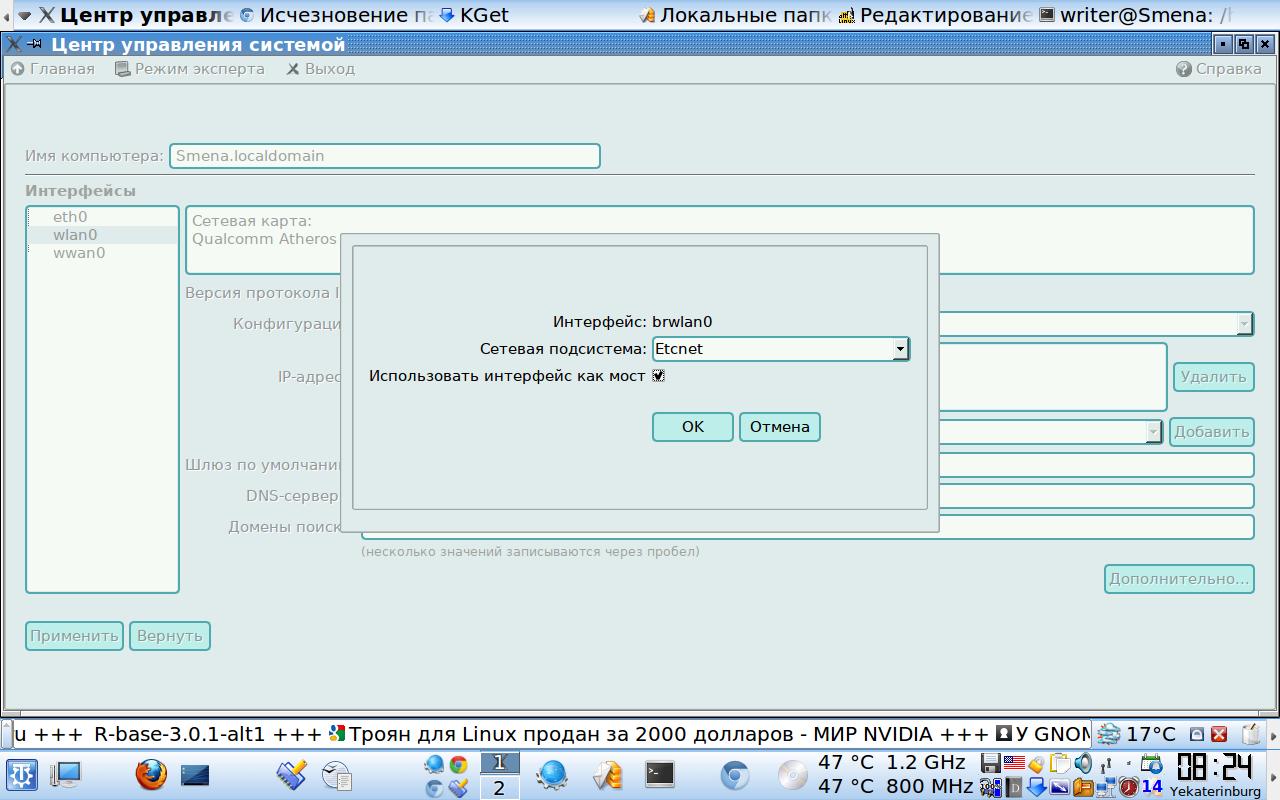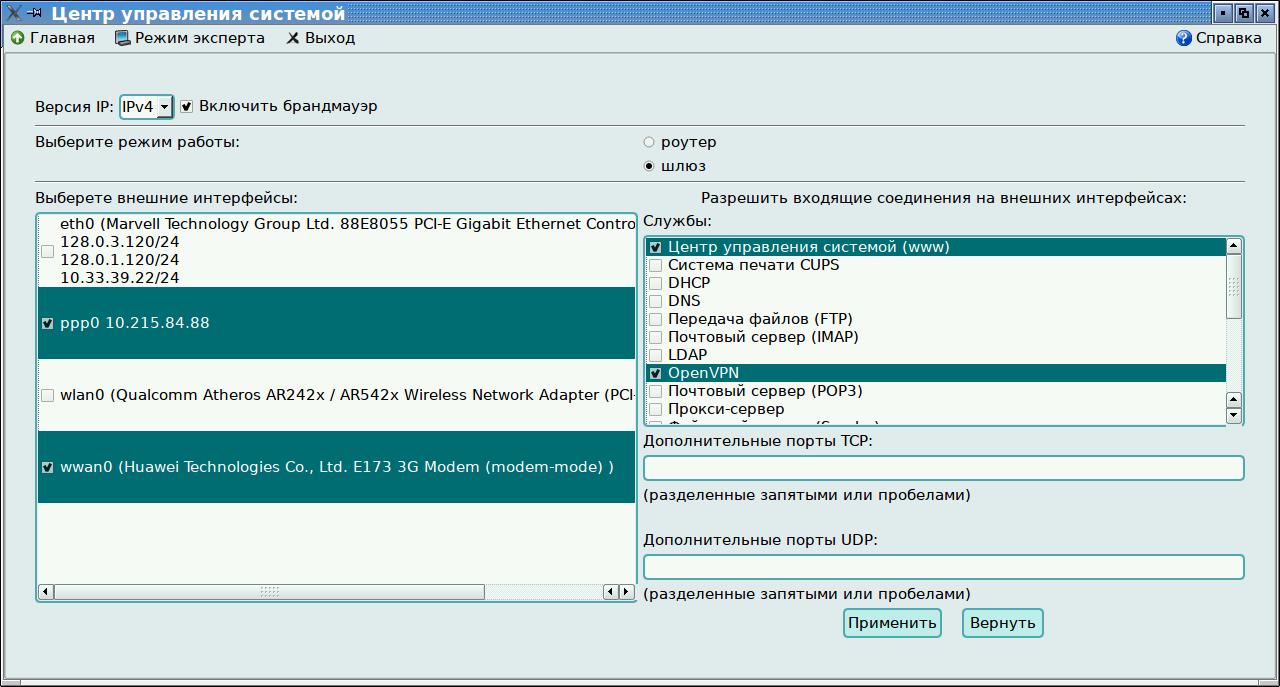Hostapd
Версия от 06:10, 19 августа 2013; HihinRuslan (обсуждение | вклад)
Настройка компьютера в качестве точки доступа для периферии (телефоны, смартфоны и т.п)
Источники информации, или вместо теории
При настройке использовал в качестве руководства :
http://www.ibm.com/developerworks/ru/library/l-wifiencrypthostapd/
http://liberatum.ru/exclusive/25350
плюс готовые заготовки конфигов в пакетах dhcpd и hostapd.
Не углубляясь в теорию
Устанавливаю hostapd и dhcpd
apt-get install hostapd dhcpd
Создаю конфиг hostapd.conf
##### hostapd configuration file ##############################################
# Empty lines and lines starting with # are ignored
# AP netdevice name (without 'ap' postfix, i.e., wlan0 uses wlan0ap for
# management frames); ath0 for madwifi
interface=wlan0
#bridge=brbr0
logger_syslog=-1
logger_syslog_level=2
logger_stdout=-1
logger_stdout_level=2
# Dump file for state information (on SIGUSR1)
dump_file=/tmp/hostapd.dump
ctrl_interface=/var/run/hostapd
ctrl_interface_group=0
##### IEEE 802.11 related configuration #######################################
# SSID to be used in IEEE 802.11 management frames
ssid=MySSID
country_code=US
hw_mode=g
channel=1
beacon_int=100
dtim_period=2
max_num_sta=255
rts_threshold=2347
fragm_threshold=2346
macaddr_acl=0
auth_algs=1
ignore_broadcast_ssid=0
# Default WMM parameters (IEEE 802.11 draft; 11-03-0504-03-000e):
# for 802.11a or 802.11g networks
# These parameters are sent to WMM clients when they associate.
# The parameters will be used by WMM clients for frames transmitted to the
# access point.
#
# note - txop_limit is in units of 32microseconds
# note - acm is admission control mandatory flag. 0 = admission control not
# required, 1 = mandatory
# note - here cwMin and cmMax are in exponent form. the actual cw value used
# will be (2^n)-1 where n is the value given here
#
wmm_enabled=1
#
# WMM-PS Unscheduled Automatic Power Save Delivery [U-APSD]
# Enable this flag if U-APSD supported outside hostapd (eg., Firmware/driver)
#uapsd_advertisement_enabled=1
#
# Low priority / AC_BK = background
wmm_ac_bk_cwmin=4
wmm_ac_bk_cwmax=10
wmm_ac_bk_aifs=7
wmm_ac_bk_txop_limit=0
wmm_ac_bk_acm=0
# Note: for IEEE 802.11b mode: cWmin=5 cWmax=10
#
# Normal priority / AC_BE = best effort
wmm_ac_be_aifs=3
wmm_ac_be_cwmin=4
wmm_ac_be_cwmax=10
wmm_ac_be_txop_limit=0
wmm_ac_be_acm=0
# Note: for IEEE 802.11b mode: cWmin=5 cWmax=7
#
# High priority / AC_VI = video
wmm_ac_vi_aifs=2
wmm_ac_vi_cwmin=3
wmm_ac_vi_cwmax=4
wmm_ac_vi_txop_limit=94
wmm_ac_vi_acm=0
# Note: for IEEE 802.11b mode: cWmin=4 cWmax=5 txop_limit=188
#
# Highest priority / AC_VO = voice
wmm_ac_vo_aifs=2
wmm_ac_vo_cwmin=2
wmm_ac_vo_cwmax=3
wmm_ac_vo_txop_limit=47
wmm_ac_vo_acm=0
##### IEEE 802.1X-2004 related configuration ##################################
# EAPOL-Key index workaround (set bit7) for WinXP Supplicant (needed only if
# only broadcast keys are used)
eapol_key_index_workaround=0
##### Integrated EAP server ###################################################
# Optionally, hostapd can be configured to use an integrated EAP server
# to process EAP authentication locally without need for an external RADIUS
# server. This functionality can be used both as a local authentication server
# for IEEE 802.1X/EAPOL and as a RADIUS server for other devices.
# Use integrated EAP server instead of external RADIUS authentication
# server. This is also needed if hostapd is configured to act as a RADIUS
# authentication server.
eap_server=0
##### RADIUS client configuration #############################################
# for IEEE 802.1X with external Authentication Server, IEEE 802.11
# authentication with external ACL for MAC addresses, and accounting
# The own IP address of the access point (used as NAS-IP-Address)
own_ip_addr=127.0.0.1
##### WPA/IEEE 802.11i configuration ##########################################
# Enable WPA. Setting this variable configures the AP to require WPA (either
# WPA-PSK or WPA-RADIUS/EAP based on other configuration). For WPA-PSK, either
# wpa_psk or wpa_passphrase must be set and wpa_key_mgmt must include WPA-PSK.
# Instead of wpa_psk / wpa_passphrase, wpa_psk_radius might suffice.
# For WPA-RADIUS/EAP, ieee8021x must be set (but without dynamic WEP keys),
# RADIUS authentication server must be configured, and WPA-EAP must be included
# in wpa_key_mgmt.
# This field is a bit field that can be used to enable WPA (IEEE 802.11i/D3.0)
# and/or WPA2 (full IEEE 802.11i/RSN):
# bit0 = WPA
# bit1 = IEEE 802.11i/RSN (WPA2) (dot11RSNAEnabled)
wpa=2
# WPA pre-shared keys for WPA-PSK. This can be either entered as a 256-bit
# secret in hex format (64 hex digits), wpa_psk, or as an ASCII passphrase
# (8..63 characters) that will be converted to PSK. This conversion uses SSID
# so the PSK changes when ASCII passphrase is used and the SSID is changed.
# wpa_psk (dot11RSNAConfigPSKValue)
# wpa_passphrase (dot11RSNAConfigPSKPassPhrase)
#wpa_psk=0123456789abcdef0123456789abcdef0123456789abcdef0123456789abcdef
wpa_passphrase=My_Password
# Optionally, WPA PSKs can be read from a separate text file (containing list
# of (PSK,MAC address) pairs. This allows more than one PSK to be configured.
# Use absolute path name to make sure that the files can be read on SIGHUP
# configuration reloads.
#wpa_psk_file=/etc/hostapd.wpa_psk
# Optionally, WPA passphrase can be received from RADIUS authentication server
# This requires macaddr_acl to be set to 2 (RADIUS)
# 0 = disabled (default)
# 1 = optional; use default passphrase/psk if RADIUS server does not include
# Tunnel-Password
# 2 = required; reject authentication if RADIUS server does not include
# Tunnel-Password
#wpa_psk_radius=0
# Set of accepted key management algorithms (WPA-PSK, WPA-EAP, or both). The
# entries are separated with a space. WPA-PSK-SHA256 and WPA-EAP-SHA256 can be
# added to enable SHA256-based stronger algorithms.
# (dot11RSNAConfigAuthenticationSuitesTable)
#wpa_key_mgmt=WPA-PSK WPA-EAP
wpa_key_mgmt=WPA-PSK
# Set of accepted cipher suites (encryption algorithms) for pairwise keys
# (unicast packets). This is a space separated list of algorithms:
# CCMP = AES in Counter mode with CBC-MAC [RFC 3610, IEEE 802.11i/D7.0]
# TKIP = Temporal Key Integrity Protocol [IEEE 802.11i/D7.0]
# Group cipher suite (encryption algorithm for broadcast and multicast frames)
# is automatically selected based on this configuration. If only CCMP is
# allowed as the pairwise cipher, group cipher will also be CCMP. Otherwise,
# TKIP will be used as the group cipher.
# (dot11RSNAConfigPairwiseCiphersTable)
# Pairwise cipher for WPA (v1) (default: TKIP)
wpa_pairwise=TKIP CCMP
# Pairwise cipher for RSN/WPA2 (default: use wpa_pairwise value)
rsn_pairwise=CCMP
Кофигурирую dhcpd
Редактирую, или создаю /etc/dhcp/dhcpd,conf
# See dhcpd.conf(5) for further configuration
ddns-update-style none;
subnet 192.168.133.0 netmask 255.255.255.0 {
option routers 192.168.133.1;
option subnet-mask 255.255.255.0;
option domain-name-servers 192.168.133.1, 8.8.8.8;
range dynamic-bootp 192.168.133.128 192.168.133.254;
default-lease-time 21600;
max-lease-time 43200;
}
Указываю, что wlan0, используется как мост
Через acc для интерфейса wlan0 указываю, что он используется как мост, управляется etcnet и имеет адрес 192.168.133.1,

Указываю, что компьютер работает, как шлюз
Там-же в асс (Внешние сети) указываю, что компьютер работает как шлюз, и указаю внешний интерфейс (у меня сейчас это ppp0).
Получившиеся конфиги в /etc/net:
# cat /etc/net/ifaces/wlan0/options
TYPE=eth
BOOTPROTO=static
# cat /etc/net/ifaces/brwlan0/ipv4address
192.168.133.1/24
# cat /etc/net/ifaces/brwlan0/options
TYPE=bri
BOOTPROTO=static
CONFIG_WIRELESS=yes
CONFIG_IPV4=yes
DISABLED=no
NM_CONTROLLED=no
HOST=wlan0
Предположение
Возможно в конфиге hostapd можно прописать ip адрес интерфейса, там в комментариях что-то такое есть :
....
##### RADIUS client configuration #############################################
# for IEEE 802.1X with external Authentication Server, IEEE 802.11
# authentication with external ACL for MAC addresses, and accounting
# The own IP address of the access point (used as NAS-IP-Address)
own_ip_addr=127.0.0.1
.....
# Network Authentication Type
# This parameter indicates what type of network authentication is used in the
# network.
# format: <network auth type indicator (1-octet hex str)> [redirect URL]
# Network Authentication Type Indicator values:
# 00 = Acceptance of terms and conditions
# 01 = On-line enrollment supported
# 02 = http/https redirection
# 03 = DNS redirection
#network_auth_type=00
#network_auth_type=02http://www.example.com/redirect/me/here/
# IP Address Type Availability
# format: <1-octet encoded value as hex str>
# (ipv4_type & 0x3f) << 2 | (ipv6_type & 0x3)
# ipv4_type:
# 0 = Address type not available
# 1 = Public IPv4 address available
# 2 = Port-restricted IPv4 address available
# 3 = Single NATed private IPv4 address available
# 4 = Double NATed private IPv4 address available
# 5 = Port-restricted IPv4 address and single NATed IPv4 address available
# 6 = Port-restricted IPv4 address and double NATed IPv4 address available
# 7 = Availability of the address type is not known
# ipv6_type:
# 0 = Address type not available
# 1 = Address type available
# 2 = Availability of the address type not known
#ipaddr_type_availability=14
# Domain Name
# format: <variable-octet str>[,<variable-octet str>]
#domain_name=example.com,another.example.com,yet-another.example.com
но я с этим не разбирался.
В дополнение
Создание точки доступа с помощью NetworkManager
Что не указал выше, посчитав это само-сабой разумеющимися :
В качестве промежуточного dns используется dnsmasq.
